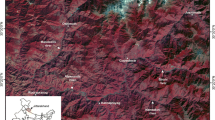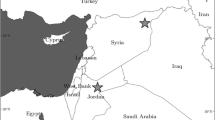Abstract
Over the past decades, the Southeast Atlantic Forest in Paraíba do Sul River Valley has suffered intense deforestation and human disturbances. Due to the Atlantic Forest biodiversity and the economic relevance of such a region in Brazil, spatial-temporal analyses are of crucial importance to protect the forest, as well as to support economic decision-making of public and private agents. In this context, the use of change detection techniques applied to remote sensing imagery arises as a powerful tool to track and map the Earth’s surface transformations. Therefore, this work investigates the effectiveness and practical feasibility of distinct unsupervised change detection approaches when they are applied to reveal the spatial-temporal dynamics in Paraíba do Sul River Valley across the last four decades. Different change detection approaches such as Change Vector Analysis (CVA), a K-Means and Principal Component Analysis (PCA-KM) framework, and a Alternating Sequential Filtering (ASF) based process were taken and properly tuned to cope with Landsat image series. The analysis of the results revealed a permanent land cover change rate over the last decades. Moreover, these changes do not necessary occur in the same locations, as it was confirmed the existence of successive modifications in original coverage of the study area. Another observed aspect is that the simplest technique for detecting changes, CVA, turned out to be the best approach to map the changes in the examined region.







Similar content being viewed by others
Data Availability Statement
Data and codes are freely available at https://github.com/rogerionegri/UCD.
References
Gomes, C., Reschilian, P. R., & Uehara. A. Y. (2018) Perspectivas do planejamento regional do Vale do Paraíba e litoral norte: marcos históricos e a institucionalização da região metropolitana no Plano de Ação da Macrometrópole Paulista. urbe. Revista Brasileira de Gestão Urbana, 10:154 – 171, 04. https://doi.org/10.1590/2175-3369.010.001.ao07
Myers, N., Mittermeier, R. A., Mittermeier, C. G., Fonseca, G. A. B., & Kent, J. (2000). Biodiversity hotspots for conservation priorities. Nature,403(6772), 853–858.
Cincotta, R., Wisnewski, J., & Engelman, R. (2000) Human populations in the biodiversity hotspots. Nature, 404:990–2, 05. https://doi.org/10.1038/35010105
Dean, W. (1997) A Ferro e Fogo: A Historia da Devastação da Mata Atlantica Brasileira. Companhia das Letras São Paulo.
Wu, C., Du, B., & Zhang, L. (2014). Slow Feature Analysis for Change Detection in Multispectral Imagery. IEEE Transactions on Geoscience and Remote Sensing, 52(5), 2858–2874. https://doi.org/10.1109/TGRS.2013.2266673
(2017) SMA. Atlas Dos Remanescentes Florestais da Mata Atlantica: 2015-2016. techreport, Fundao SOS Mata Atlantica and National Institute for Space Research, Sao Paulo, Brazil. https://www.sosma.org.br/wp-content/uploads/2019/05/Atlas-mata-atlantica_17-18.pdf
Itani, M. R., Barros, C. M., Figueiredo, F. E. L., Andrade, M. R. M., Mansor, M. T. C., Mangabeira, R. L., & Carvalho, V. S. (2011) Subsídios ao planejamento ambiental: Unidade de Gerenciamento de Recursos hídricos Paraíba do Sul–UGRHI 02 – Subsidies for Environmental Planning: Hydrographic Unit Water of Resources Management of Paraíba do Sul–UGRHI 02. techreport, Sao Paulo State Environment Secretariat, Sao Paulo, Brazil. p. 204 http://arquivos.ambiente.sp.gov.br/publicacoes/2016/12/Subsidios_ao_Planejamento_Ambiental_UGRHI-021.pdf
Silva, R. F. B., Batistella, M., & Moran, E. F. (2017). Socioeconomic changes and environmental policies as dimensions of regional land transitions in the atlantic forest, brazil. Environmental Science & Policy,74, 14–22.
Amitrano, D., Guida, R., & Iervolino, P. (2020) Semantic unsupervised change detection of natural land cover with multitemporal object-based analysis on sar images. IEEE Transactions on Geoscience and Remote Sensing, pages 1–21. https://doi.org/10.1109/TGRS.2020.3029841
Fazel, M. A., Homayouni, S., & Amini, J. (2013) Kernel-based unsupervised change detection of agricultural lands using multi-temporal polarimetric sar data. ISPRS - International Archives of the Photogrammetry, Remote Sensing and Spatial Information Sciences, XL-1/W3:169–173. DOI 10.5194/isprsarchives-XL-1-W3-169-2013. https://www.int-arch-photogramm-remote-sens-spatial-inf-sci.net/XL-1-W3/169/2013/
Durieux, A. M. S., Calef, M. T., Arko, S., Chartrand, R., Kontgis, C., Keisler, R., et al. (2019). Monitoring forest disturbance using change detection on synthetic aperture radar imagery. In M. E. Zelinski, T. M. Taha, J. Howe, A. A. S. Awwal, & K. M. Iftekharuddin (Eds.), Applications of Machine Learning (pp. 307–320)., volume 11139 SPIE: International Society for Optics and Photonics. https://doi.org/10.1117/12.2528945
Hame, T., Heiler, I., & Miguel-Ayanz, J. S. (1998). An unsupervised change detection and recognition system for forestry. International Journal of Remote Sensing,19(6), 1079–1099. https://doi.org/10.1080/014311698215612
Lei, T., Xue, D., Lv, Z., Li, S., Zhang, Y., & Asoke, K. N. (2018). Unsupervised change detection using fast fuzzy clustering for landslide mapping from very high-resolution images. Remote Sensing,10(9). https://doi.org/10.3390/rs10091381
Sublime, J., & Kalinicheva, E. (2019). Automatic post-disaster damage mapping using deep-learning techniques for change detection: Case study of the tohoku tsunami. Remote Sensing,11(9). https://doi.org/10.3390/rs11091123. https://www.mdpi.com/2072-4292/11/9/1123
Sathya, N., Kalaiselvi, S., Gomathi, V., and Srinivasagan, K. G. (2014) Unsupervised monitoring of urban land use and land cover change detection in multitemporal images. In 2014 International Conference on Electronics and Communication Systems (ICECS), pages 1–5. DOI 10.1109/ECS.2014.6892722
USGS. United States Geological Survey. EarthExplorer platform and EROS data center. U.S. Dept. of the Interior, U.S. Geological Survey, 2019.
Seto, K. C., Woodcock, C., Song, C., Huang, X., Lu, J., & Kaufmann, R. (2002). Monitoring land-use change in the pearl river delta using landsat tm. International Journal of Remote Sensing,23(10), 1985–2004.
Lu, D., Mausel, P., Brondizio, E., & Moran, E. (2004). Change detection techniques. International journal of remote sensing,25(12), 2365–2401.
Mura, M. D., Benediktsson, J. A., Bovolo, F., & Bruzzone, L. (2008). An unsupervised technique based on morphological filters for change detection in very high resolution images. IEEE Geoscience and Remote Sensing Letters,5(3), 433–437.
Du, B., Ru, L., Wu, C., & Zhang, L. (2019). Unsupervised deep slow feature analysis for change detection in multi-temporal remote sensing images. IEEE Transactions on Geoscience and Remote Sensing,57(12), 9976–9992.
Negri, R. G., Frery, A. C., Casaca, W., Azevedo, S., Dias, M. A., Silva, E. A., & Alcantara, E. H. (2020) Spectral-spatial-aware unsupervised change detection with stochastic distances and support vector machines. IEEE Transactions on Geoscience and Remote Sensing, pages 1–14.
Webb, A. R., & Copsey, K. D. (2011) Statistical pattern recognition. John Wiley & Sons, Chichester, 3rd ed. edition.
Johnson, R. D., & Kasischke, E. S. (1998). Change vector analysis: a technique for the multispectral monitoring of land cover and condition. International Journal of Remote Sensing,19(3), 411–426.
Otsu, N. (1979) A threshold selection method from gray-level histograms. IEEE Trans. on Systems, Man, and Cybernetics, 9(1):62–66. https://doi.org/10.1109/TSMC.1979.4310076
Kittler, J., & Illingworth, J. (1986). Minimum error thresholding. Pattern Recognition,19(1), 41–47. https://doi.org/10.1016/0031-3203(86)90030-0
Jolliffe, I. (2011). Principal component analysis. Springer.
Deng, J. S., Wang, K., Deng, Y. H., & Qi, G. J. (2008). Pca-based land-use change detection and analysis using multitemporal and multisensor satellite data. International Journal of Remote Sensing,29(16), 4823–4838. https://doi.org/10.1080/01431160801950162
Martinez-Izquierdo, M. E., Molina-Sanchez, I., and M.-B. M. C. (2019) Efficient dimensionality reduction using principal component analysis for image change detection. IEEE Latin America Transactions, 17(04):540–547.
Song, M., Zhong, Y., Ma, A., & Zhang, L. (2017) Unsupervised change detection for remote sensing images based on principal component analysis and differential evolution. In Y. Shi, K. C. Tan, M. Zhang, K. Tang, X. Li, Q. Zhang, Y. Tan, M. Middendorf, and Y. Jin, editors, Simulated Evolution and Learning, pages 786–796. Springer International Publishing.
Celik, T. (2009). Unsupervised change detection in satellite images using principal component analysis and \(k\)-means clustering. IEEE Geoscience and Remote Sensing Letters,6(4), 772–776.
Vecchi, D., Galeazzo, D. A., Harb, M., & Dell’Acqua, F. (2015) Unsupervised change detection for urban expansion monitoring: An object-based approach. In 2015 IEEE International Geoscience and Remote Sensing Symposium (IGARSS), pages 350–352. https://doi.org/10.1109/IGARSS.2015.7325772
Azevedo, S. A., S. E. A., Colnago, M., Negri, R. G., & Casaca, W. (2019) Shadow detection using object area-based and morphological filtering for very high-resolution satellite imagery of urban areas. Journal of Applied Remote Sensing, 13(3):1 – 16. https://doi.org/10.1117/1.JRS.13.036506
Gonzalez, R. C., & Woods, R. E. (2017) Digital image processing. Pearson, 4th edition, 2017.
(2019) IBGE. Demographic data 2010. The Brazilian Institute of Geography and Statistics (Instituto Brasileiro de Geografia e Estatastca). URL www.ibge.gov.br
(2019) USGS: United States Geological Survey. EarthExplorer platform and EROS data center.U.S. Dept. of the Interior, U.S. Geological Survey. earthexplorer.usgs.gov
(2019) USGS. Product guide: Landsat 4-7 ecosystem disturbance adaptive processing system (LEDAPS). techreport, United States Geologycal Service. Accessed on 1 August 2019. https://www.usgs.gov/media/files/landsat-4-7-surface-reflectance-code-ledaps-product-guide
(2017) USGS. Product guide: Landsat 8 surface reflectance code (LASRC) product. techreport, United States Geologycal Service. Accessed on 1 August 2019. https://www.usgs.gov/media/files/land-surface-reflectance-code-lasrc-product-guide
Souza, C. M., Shimbo, J. Z., Rosa, M. R., Parente, L. L., Alencar, A. A., Rudorff, B. F. T., et al. (2020). Reconstructing three decades of land use and land cover changes in brazilian biomes with landsat archive and earth engine. Remote Sensing,12(17), DOI 10.3390/rs12172735. https://www.mdpi.com/2072-4292/12/17/2735
Rijsbergen, C. J. V. (1979). Information Retrieval (2nd ed.). Newton, MA, USA: Butterworth-Heinemann.
Andrade, D. J, Souza, A. A. M., & Gomes, C. (2019). Temporal analysis of urban expansion in the municipalities of the paraíba paulista valley. Mercator (Fortaleza), 18.
Silva, R. F. B., Batistella, M., Moran, E. F., & Lu, D. (2017). Land changes fostering atlantic forest transition in brazil: Evidence from the paraba valley. The Professional Geographer,69(1), 80–93. https://doi.org/10.1080/00330124.2016.1178151
R. Singh, S. & Talwar (2015). Performance analysis of different threshold determination techniques for change vector analysis. Journal of the Geological Society of India, 86(86):52–58. https://doi.org/10.1007/s12594-015-0280-x
Aplin, P. (2006). On scales and dynamics in observing the environment. International Journal of Remote Sensing,27(11), 2123–2140. https://doi.org/10.1080/01431160500396477
Acknowledgements
Authors are highly thankful to the US Geological Survey and NASA for providing free access of Landsat images. We sincerely thank anonymous reviewers whose constructive comments and suggestions improved the quality of the manuscript.
Funding
G. R. Sapucci and R. G. Negri acknowledge the support from São Paulo Research Foundation - FAPESP (Grant 2017/14614-1, 2018/01033-3).
Author information
Authors and Affiliations
Contributions
G. R. Sapucci: conceptualization, methodology, validation, and writing the original draft; R. G. Negri: conceptualization, methodology, software, validation, editing, and supervision; W. Casaca: validation and editing; K. G. Massi: validation, editing, and supervision.
Corresponding author
Ethics declarations
Conflict of Interest
The authors declare that they have no conflict of interest.
Additional information
Publisher’s Note
Springer Nature remains neutral with regard to jurisdictional claims in published maps and institutional affiliations.
Rights and permissions
About this article
Cite this article
Sapucci, G.R., Negri, R.G., Casaca, W. et al. Analyzing Spatio-temporal Land Cover Dynamics in an Atlantic Forest Portion Using Unsupervised Change Detection Techniques. Environ Model Assess 26, 581–590 (2021). https://doi.org/10.1007/s10666-021-09758-6
Received:
Accepted:
Published:
Issue Date:
DOI: https://doi.org/10.1007/s10666-021-09758-6




